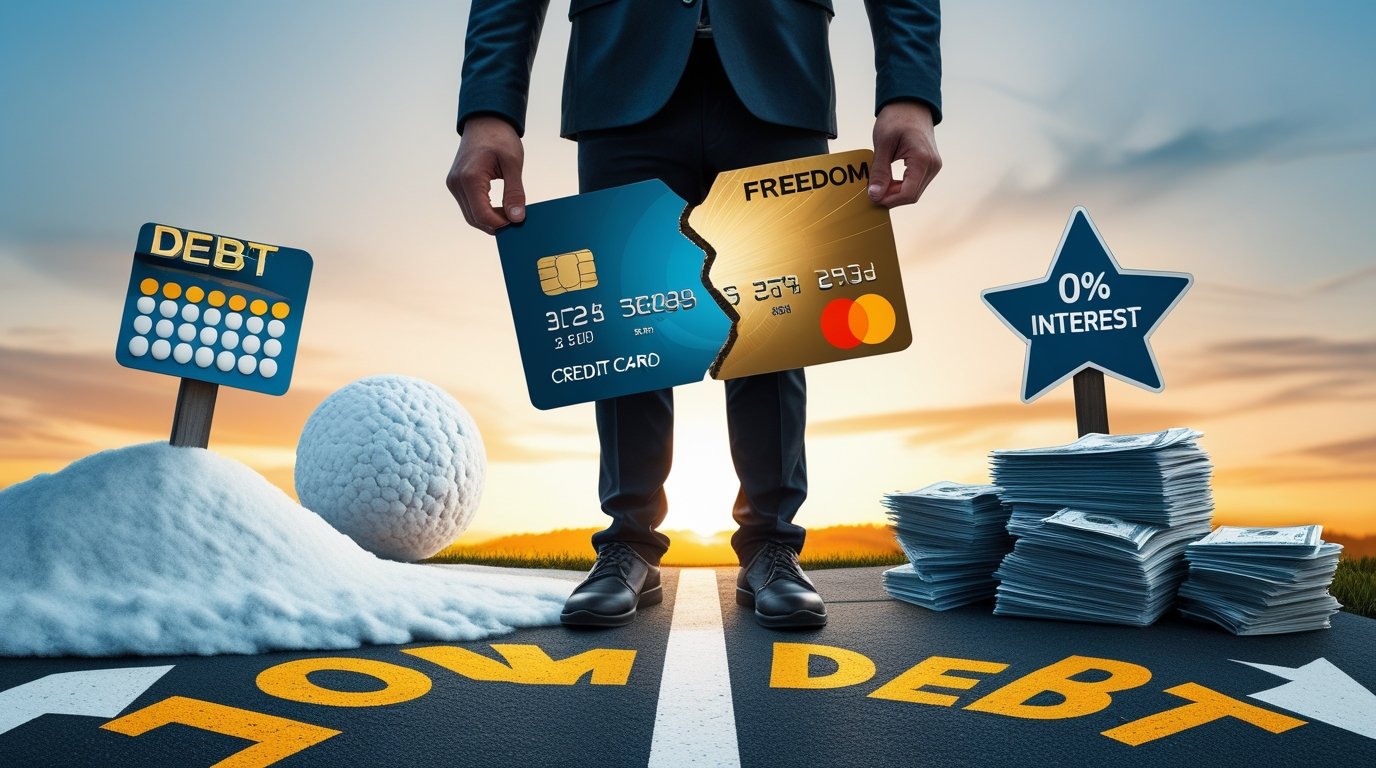Struggling with credit card debt can feel like running on a treadmill—exhausting and endless. High interest rates and mounting balances can drain your finances and peace of mind. But here’s the good news: with the right strategies to pay off credit card debt faster, you can break free and reclaim control in 2025. This article outlines actionable, beginner-friendly methods to tackle debt efficiently, saving you money and stress. Whether you owe $1,000 or $20,000, these proven techniques will help you achieve a debt-free life.
Why Tackle Credit Card Debt in 2025?
Credit card interest rates are expected to hover around 20%–25% in 2025, making debt repayment more urgent than ever. By acting now, you can avoid thousands in interest and build a stronger financial future. Let’s dive into the best strategies to eliminate your credit card debt quickly.
1. Debt Avalanche Method: Prioritize High-Interest Cards
What Is the Debt Avalanche Method?
The debt avalanche method focuses on paying off the credit card with the highest interest rate first while making minimum payments on others. This minimizes total interest paid over time.
Why Use It in 2025?
- Cost-Effective: Saves the most on interest charges.
- Faster Payoff: Reduces the overall repayment timeline.
- Motivating: Seeing high-interest debt disappear boosts momentum.
Real-World Example
Emma, a 30-year-old graphic designer, had $15,000 in debt across three cards with interest rates of 22%, 18%, and 12%. Using the avalanche method, she paid $800 monthly toward the 22% card while covering minimums on others. By mid-2025, she eliminated the highest-rate card, saving $1,200 in interest.
How to Start
- List all cards with balances, interest rates, and minimum payments.
- Allocate extra funds to the highest-rate card.
- Once paid off, roll payments to the next highest-rate card.
Suggested Visual: A table showing Emma’s debt payoff progress over 12 months.
2. Debt Snowball Method: Build Momentum with Small Wins
What Is the Debt Snowball Method?
The debt snowball method involves paying off the smallest balance first while maintaining minimum payments on other cards, then moving to the next smallest balance.
Why Choose It in 2025?
- Psychological Boost: Quick wins keep you motivated.
- Simple to Follow: Ideal for beginners overwhelmed by debt.
- Flexible: Works with any budget size.
Case Study
Jake, a 35-year-old teacher, owed $10,000 across four cards. He focused on a $1,500 balance first, paying $500 monthly while covering minimums elsewhere. By 2025, he cleared two cards, gaining confidence to tackle larger balances.
Getting Started
- List debts from smallest to largest balance.
- Pay as much as possible toward the smallest debt.
- Apply freed-up funds to the next smallest debt.
Internal Link: Compare Debt Avalanche vs. Snowball.
Outbound Link: Dave Ramsey’s Debt Snowball Guide.
3. Balance Transfer Cards: Lower Interest Costs
What Are Balance Transfer Cards?
Balance transfer cards offer a 0% or low introductory APR for 12–21 months, allowing you to transfer existing credit card balances and pay them off without accruing interest.
Why Use Them in 2025?
- Interest Savings: Pay down principal faster with no interest.
- Consolidation: Combine multiple card balances into one payment.
- New Offers: 2025 sees competitive 0% APR deals due to market trends.
Real-World Example
Sarah, a 28-year-old nurse, transferred $8,000 in debt to a card with a 0% APR for 18 months. By paying $450 monthly, she cleared the balance before the promotional period ended, saving $1,600 in interest.
How to Start
- Research cards with long 0% APR periods (e.g., Citi Simplicity, Chase Slate).
- Check balance transfer fees (typically 3%–5%).
- Create a repayment plan to clear the balance before the promo ends.
Suggested Visual: Infographic comparing balance transfer savings vs. standard repayment.
4. Debt Consolidation Loans: Simplify Payments
What Is a Debt Consolidation Loan?
A debt consolidation loan combines multiple credit card debts into a single loan with a lower interest rate, often through a bank or credit union.
Why Consider It in 2025?
- Lower Rates: Personal loans average 10%–12% APR, compared to 20%+ for cards.
- Fixed Payments: Predictable monthly payments simplify budgeting.
- Credit Score Boost: Timely loan payments improve your credit.
Case Study
Mike, a 40-year-old mechanic, consolidated $12,000 in credit card debt into a 10% APR loan with a 3-year term. His monthly payment dropped from $600 to $400, and he paid off the debt by late 2025, saving $2,000 in interest.
Getting Started
- Check your credit score to qualify for lower rates.
- Compare lenders like SoFi, LightStream, or local credit unions.
- Avoid new credit card debt while repaying the loan.
Outbound Link: SoFi’s Debt Consolidation Guide.
5. Budget Overhaul: Free Up Cash for Debt Repayment
What Is a Budget Overhaul?
A budget overhaul involves cutting unnecessary expenses and redirecting savings toward debt repayment, often using methods like the 50/30/20 rule (50% needs, 30% wants, 20% savings/debt).
Why It Works in 2025?
- Maximized Payments: More cash flow accelerates debt payoff.
- Sustainable: Builds long-term financial habits.
- Tech Tools: Budgeting apps like YNAB and Rocket Money are more advanced in 2025.
Real-World Example
Lisa, a 32-year-old marketer, reduced dining out and subscription costs by $200 monthly. She applied this to her $7,000 credit card debt, paying it off 6 months early and saving $800 in interest.
How to Start
- Track spending for 30 days to identify cuts.
- Use apps like YNAB or Mint to set debt repayment goals.
- Redirect savings to your chosen debt strategy (e.g., avalanche or snowball).
Suggested Visual: Pie chart showing the 50/30/20 budget breakdown.
What’s New in 2025?
- AI Budgeting Tools: Apps now use AI to predict spending and suggest debt repayment plans.
- Lower Balance Transfer Fees: Some issuers are reducing fees to compete in 2025.
- Debt Forgiveness Programs: Expanded eligibility for certain low-income borrowers.
Pros and Cons Comparison Table
| Strategy | Pros | Cons |
|---|---|---|
| Debt Avalanche | Saves most on interest | Slower initial wins |
| Debt Snowball | Quick wins, motivating | Higher total interest |
| Balance Transfer | 0% APR, consolidation | Transfer fees, time-limited |
| Debt Consolidation Loan | Lower rates, fixed payments | Requires good credit |
| Budget Overhaul | Sustainable, no new debt | Requires discipline |
FAQ Section
1. What’s the Fastest Way to Pay Off Credit Card Debt in 2025?
The fastest method depends on your situation. The debt avalanche method saves the most on interest by targeting high-rate cards first, while a balance transfer card with 0% APR can accelerate payoff if you clear the balance during the promotional period. Combine with a budget overhaul to maximize payments. For example, paying $500 monthly on a $5,000 balance at 20% interest takes 12 months with avalanche vs. 15 months with minimum payments, saving $600 in interest.
2. Is the Debt Snowball Method Effective for Large Debts?
Yes, but it’s less cost-effective for large debts due to higher interest costs. The debt snowball method prioritizes small balances for quick wins, which is motivating but may cost more over time. For large debts, consider the avalanche method or a balance transfer. For instance, Jake paid off $10,000 using snowball, but switching to avalanche could’ve saved him $500 in interest.
3. Are Balance Transfer Cards Worth the Fees?
Balance transfer cards are worth it if you can pay off the balance during the 0% APR period. A 3% fee on a $5,000 transfer costs $150, but you could save $1,000 in interest at 20% APR over 18 months. Compare fees and promo periods on cards like Chase Slate or Citi Simplicity, and ensure you have a repayment plan.
4. How Does Debt Consolidation Affect My Credit Score?
A debt consolidation loan can initially lower your score due to a hard credit inquiry and new account. However, timely payments and reduced credit card balances improve your score over time. Mike’s score dropped 10 points after consolidating $12,000 but rose 50 points within a year due to consistent payments and lower credit utilization.
5. Can Budgeting Alone Pay Off Credit Card Debt?
Budgeting alone can work if you redirect significant savings to debt repayment. Lisa cut $200 monthly from her budget, paying off $7,000 in 18 months. Use apps like YNAB to track spending and the 50/30/20 rule to prioritize debt. Combine with other strategies like avalanche or balance transfers for faster results.
6. What Should I Avoid When Paying Off Credit Card Debt?
Avoid taking on new debt, missing payments, or only paying minimums, as these extend your repayment timeline and increase interest costs. Also, steer clear of debt settlement companies, which can harm your credit and charge high fees. Focus on sustainable strategies like those outlined above.
Conclusion
Paying off credit card debt in 2025 is achievable with the right strategies to pay off credit card debt faster. Whether you opt for the debt avalanche, debt snowball, balance transfer cards, debt consolidation loans, or a budget overhaul, each method offers a path to financial freedom. Start small, stay consistent, and celebrate your progress. Which strategy will you try first? Share your plan in the comments or sign up for our newsletter for more money-saving tips!

